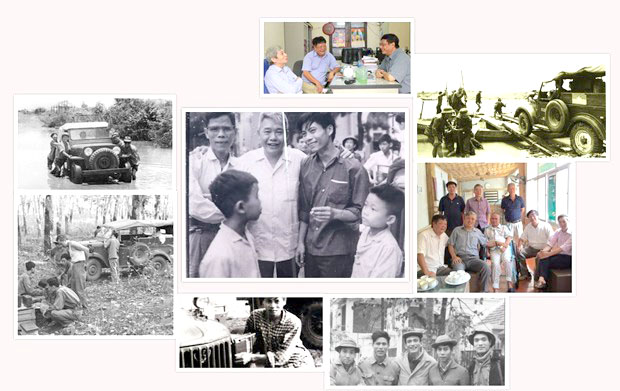 Society
Society

In a small room on the second floor of the Vietnam News Agency (VNA) fleet headquarters located in Mai Hương Zone, Hai Ba Trung District in Hà Nội, former "soldier drivers" of the VNA meet again every year.

|
| Former “soldier drivers” of the Vietnam News Agency past and present. — VNA/VNS Photo |
Viết Tôn
HÀ NỘI — In a small room on the second floor of the Vietnam News Agency (VNA) fleet headquarters located in Mai Hương Zone, Hai Bà Trưng District in Hà Nội, former "soldier drivers" of the VNA meet again every year.
Together they reminisce about working for VNA, side by side with reporters and technicians closely following the liberation army going to Sài Gòn (now HCM City) to liberate the south to reunify the country.
Memories
Recalling the proud stages of the VNA fleet, everyone has vivid memories through the ages.
Trương Đại Chiến is 70 years old this year, but still sharp as a tack. He recalled a story of more than 40 years ago when he brought a delegation of VNA reporters to the battlefield.
It was the start of winter 1971 and VNA sent a group of cadres to support the south. Chiến drove reporters, editors, telegraphers, equipment and machinery south.
Chiến remembered that once he had to spend the night at the edge of a forest, surrounded by three small graves. At night, squirrels, geckos and lizards abounded, but that did not bother Chiến.
What unsettled him was the fear of commandos and scouts, so his AK-47 was always ready.
“Once I had a mission accompanying a middle-aged man who looked very stylish. I took him through the woods. When the car ran on a flat forest with lots of termite nest with bushes, I suddenly slowed down. The fast-moving car stopped suddenly, the front of the car jumped over half a metre, making me and the man jump high. I tried to hold the steering wheel, fortunately, the man was also able to hold the handle in front thus two of us were not thrown out,” said Chiến.
“It turned out that the car collapsed in a hole. I glanced at the man, he was calm as if nothing had happened. I felt reassured and focused to drive more carefully. After that trip, I heard the man was a lieutenant colonel and the B5 Headquarters Political Commissar. He went to check the terrain of the battlefield to prepare for a big battle."
River crossing
In the 1970s, drivers like Phí Văn Sửu were considered the third generation of VNA. At that time, like Sửu, many other drivers who were sent to work on the battlefield were only in their twenties, but they were all devoted to their work.
In the memory of Sửu, a former captain of the VNA fleet, the war was fierce, but the “great drivers” gained valuable experiences while working.
Sửu recounted that to avoid enemy aircraft, every day at about 5am, his group moved as fast as they could to bring reporters where they needed to go.
"On that road, we could only go straight forward, no one was allowed to back down," Sửu said.
The road from Hà Nội to Quảng Trị was quite familiar to the driver, but going from Quảng Trị to Tây Ninh was really hard. Trường Sơn Road is full of mud and dust and the drivers had to use local roads to avoid falling bombs and stray bullets.
In newly liberated areas, people living sparsely so the process of the VNA’s reporters was more and more arduous.
Everyone in the delegation that year still remembers the story of joining boats into a ferry for vehicles across a river. Sửu still feels proud he took his car off the "ferry" in a gentle, safe way that not all drivers could do.
The river's bridge had been destroyed, so all the drivers had to wait to cross. VNA then Director General Đào Tùng devised a way to connect two boats together, then use a cross-board to make a "ferry" for vehicles to cross the river.
Sửu said the board for grafting the boats together was taken from the paved wood of the bridge that had been knocked down by the enemy. It took more than two hours to cross the river.
The most difficult thing was that the drivers had to be skilled and gently drive their cars between the two boats. Finally, the two cars were brought across the river thanks to the skill of the drivers.
Just another day on the job for VNA drivers during the war. — VNS